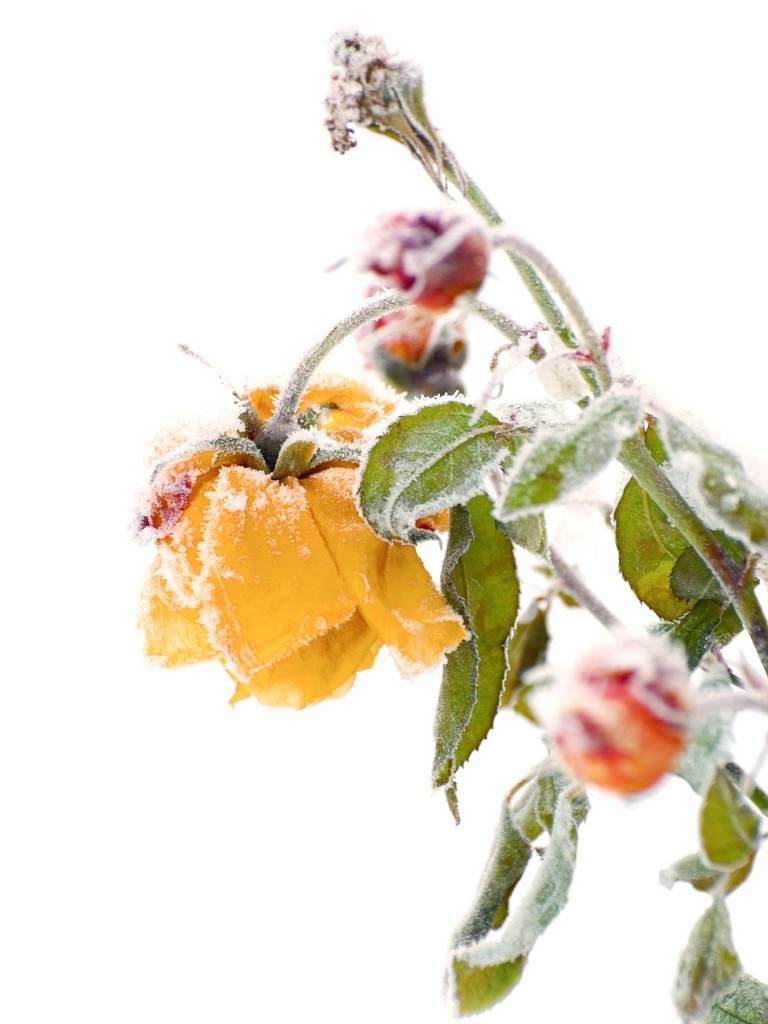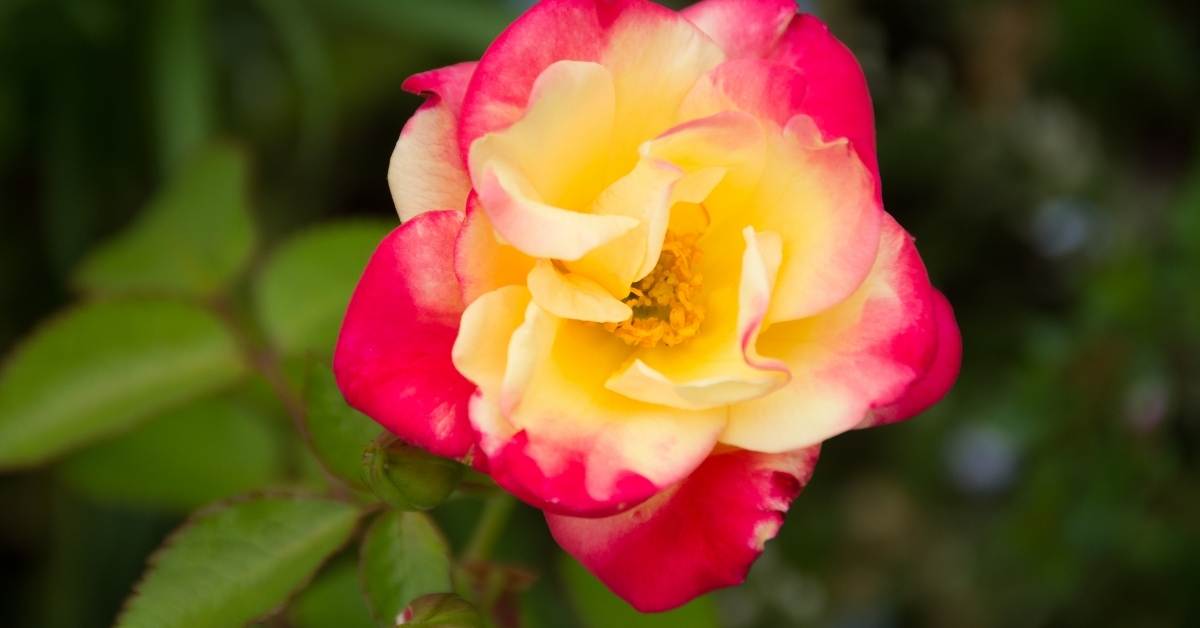Winter is a time of rest and purification for your rose garden, but it can be a time of disaster as well if you fail to take the proper precautions. Here are some useful tips for winter rose gardening in your garden or backyard.
While “old garden roses” and own-root species are generally hardy enough to make it through the winter unscathed, the more fragile varieties, such as hybrid teas and budded roses, can have a rough time if they aren’t well protected.
Winter Rose Gardening
Preparing for the ravages of winter should start way back during the rose selection process.
When you’re browsing online and printed catalogs or admiring the selection in your local home and garden store, be sure to select varieties that are capable of withstanding the coldest winter temperatures that your geographic region is capable of dishing out.
If possible, refer to your area “hardiness zone maps” before you buy.
The key to having your roses survive the cold of winter is to force them into total dormancy. Stop applying fertilizer by mid-August, and stop deadheading and cutting flowers after the beginning of October. Allow hips to form to promote dormancy further.
How To Care For Roses In Winter In Cold Areas?

In extremely cold areas, your goal is to keep the plant frozen throughout the winter and prevent them from repeatedly entering freeze/thaw/freeze cycles.
With that in mind, don’t cover your plants too early. Wait until the first hard frost has struck and the leaves begin to wither and fall.
This is an excellent time to remove ground foliage and other garden debris from around the plants that may contain diseases and insects that will hibernate during the winter and return to feed on your roses in the spring.
Take a few minutes to prune back the taller roses before you begin covering the plants for the winter. Avoid doing a thorough pruning as you’ll want to cut back the dead and diseased canes come spring. This is also a good time to tie the canes together to protect them from being damaged by the howling winds of winter.

Hilling Roses
“Hilling” is a very common winter protection method for roses. You simply pile a loose and well-drained soil or compost around and over the rose bush until you reach a depth of approximately 10-12 inches.
Be sure that whatever soil or compost material you use has no excess moisture in it. You want to have only cold and dry soil for a winter covering.
Once the soil mound has frozen completely, you can cover it with leaves, hay, or evergreen branches.
Healthy roses, protected by clean and well-drained soli or compost, have a very good chance of surviving the winter season if you take the time to prepare them properly.
Once you have put your garden to bed for the winter, take some time to clean and sharpen your tools and put your shed or garage back in order so you’ll be ready for spring.
As the days grow shorter and the nights grow longer, you’ll be ready to sit back in front of the roaring fire and start ordering next year’s roses from your favorite catalogs and websites.
Winter Protection Checklist For Roses:
Local guidance is recommended for individuals who live in colder areas; however, below are some general rules for rose shrub winter care.
Wind drying, the effect of alternate thawing and freezing cycles on the plant as winter temperatures change, the plant’s inability to take in water if the soil is frozen, and damage to the canes and bud union from the cold itself are all serious risks to the plant in the winter.
- Plant cold-hardy roses if you live somewhere with chilly winters. You’ll have fewer options this way, but you’ll save a lot of time and heartache. Many once-blooming ancient roses are quite cold-hardy; among the repeat bloomers, rugosas are extremely hardy, and many Austins and other shrub roses will fare OK. Yellow and lavender roses, in particular, are pretty delicate. Unfortunately, cold-hardiness is not a precise science; in cold weather, elements such as wind can harm roses by drying them out; thus, zone ratings are only a rough guide. Be wary of publications that label roses as “cold hardy” or “not cold hardy,” as they most likely refer to conditions in the United Kingdom, where winters are mild. Be wary of catalogs that exaggerate the cold-hardiness of their items to sell more.
- Plant self-rooting roses if you’re unsure. They will swiftly recover from the roots if they die back to the ground during a very harsh winter. Once-bloomers are exempt from this advice since they only flower on the canes from the previous year. English and Old Roses are offered as well as own-root Old Roses. It’s tough to find own-root Hybrid Teas because they’re virtually usually offered as grafted plants.
- Reduce your nitrogen fertilizer application in the Fall. This, along with the cooler temperatures, will inhibit the formation of new tender growth and allow the current growth to harden off.
- Zones 4 and 5 should stop deadheading by September 1. The plant will thereafter be able to produce hips as a result of this. Hips cause the plant to slow down its development, bloomless frequently, and stiffen its canes, all of which help it prepare for dormancy.
- Understanding rose dormancy can help you decide whether to trim your roses between late Fall and early Spring. The sap has evaporated from the canes during dormancy, leaving just empty cellulose tubes. Pruning too soon (before the sap returns) depletes the plant’s nutrition, so make sure it’s dormant before pruning in the autumn (winter). The terminal of the branches is usually when winter dieback occurs (canes). Pruning reduces the amount of accessible length that can die before reaching the ground. Pruning a dormant plant also promotes growth and sap flow in the trimmed area. This is detrimental for a dormant plant since it prevents the plant from going dormant. It is beneficial to a plant that is awakening (springtime) since it increases growth. Pruning should ideally take place before the sap begins to flow.
- Clean the rose bed of leaves and other debris to prevent disease/fungus from overwintering. To destroy bacteria on the shrub and the ground, spray it with dormant oil.
- Keep an eye on the rose’s crown. Because you want the new canes to originate from the crown, this is crucial. You may pick from several different types of protection.
- Tree leaves should cover the bed at least a foot deep.
- Rose leaves should not be used since they might be infected.
- The ideal leaves to use are oak leaves, as they drain well.
- Use a straw, cover the bed.
- Rose cones are an excellent choice.
- To cover the crown, create a mound of earth or mulch.
- In addition to one of the foregoing techniques of crown protection, wrap the entire plant in burlap if required.
- It’s critical to plan ahead. Covering the rose too soon can delay the beginning of dormancy and prevent the rose from hardening adequately. The rose may be damaged by the cold if it is protected too late.
- Tie climbers or long canes to minimize thrashing in the wind. Wrapping canes in burlap with a covering of straw for insulation can help protect them from the drying winter winds. Long canes might have to be bound and buried in harsh regions.
- Maintain good drainage in the soil, particularly as the spring rains arrive.

